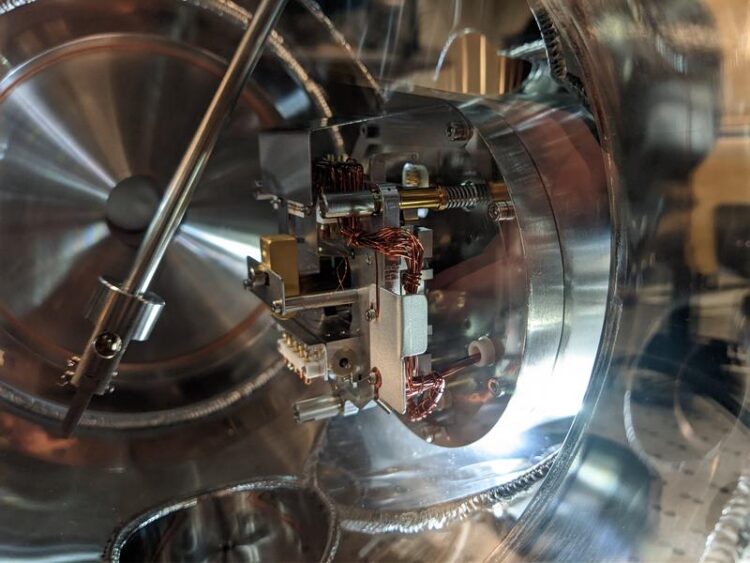Progress in the investigation of ultrafast electron dynamics using short light pulses

Looking into the vacuum chamber of the Photoemission Electron Microscope in Lund: The research team used a similar device to study electrons that had been released from a sample using laser pulses.
Credit: Jan Vogelsang
A German-Swedish team has succeeded in simultaneously studying the rapid motion of electrons with high spatial accuracy and a temporal resolution in the attosecond range. The researchers combined a special type of electron microscopy, known as photoemission electron microscopy (PEEM), with the power of attosecond physics. They used unimaginably short flashes of light to precisely control the movement of electrons and record their behaviour. In the future, the method could be used to better understand the behaviour of electrons in nanomaterials or in new types of solar cells.
When electrons move within a molecule or semiconductor, this occurs on unimaginably short time scales. A Swedish-German including physicist Dr Jan Vogelsang from the University of Oldenburg has now made significant progress towards a better understanding of these ultrafast processes: The researchers were able to track the dynamics of electrons released from the surface of zinc oxide crystals using laser pulses with spatial resolution in the nanometre range and at previously unattained temporal resolution.

Schematic representation of the experimental setup: Attosecond pulses (violet) eject electrons (green) from a crystal surface. The photoemission electron microscope (cone-shaped instrument at top) examines the rapid movements of the electrons. Image: Jan Vogelsang
With these experiments, the team demonstrated the applicability of a method that could be used to better understand the behaviour of electrons in nanomaterials and new types of solar cells, among other applications. Researchers from Lund University, including Professor Dr Anne L’Huillier, one of last year’s three Nobel laureates in physics, were involved in the study, which was published in the science journal Advanced Physics Research.
In their experiments, the research team combined a special type of electron microscopy known as photoemission electron microscopy (PEEM) with attosecond physics technology. The scientists use extremely short-duration light pulses to excite electrons and record their subsequent behaviour. “The process is much like a flash capturing a fast movement in photography,” Vogelsang explained. An attosecond is incredibly short – just a billionth of a billionth of a second.
As the team reports, similar experiments had so far failed to attain the temporal accuracy required to track the electrons’ motion. The tiny elementary particles whizz around much faster than the larger and heavier atomic nuclei. In the present study, however, the scientists were able to combine the two technologically demanding techniques, photoemission electron microscopy and attosecond microscopy, without compromising either the spatial or temporal resolution. “We have now finally reached the point where we can use attosecond pulses to investigate in detail the interaction of light and matter at the atomic level and in nanostructures,” said Vogelsang.
One factor which made this progress possible was the use of a light source that generates a particularly high quantity of attosecond flashes per second – in this case 200,000 light pulses per second. Each flash released on average one electron from the surface of the crystal, allowing the researchers to study their behaviour without them influencing each other. “The more pulses per second you generate, the easier it is to extract a small measurement signal from a dataset,” explained the physicist.
Anne L’Huillier’s laboratory at Lund University (Sweden), where the experiments for the present study were carried out, is one of the few research laboratories worldwide that has the technological equipment required for such experiments. Vogelsang, who was a postdoctoral researcher at Lund University from 2017 to 2020, is currently in the process of setting up a similar experimental laboratory at the University of Oldenburg. In the future, the two teams plan to continue their investigations and explore the behaviour of electrons in various materials and nanostructures.
Vogelsang has headed the Attosecond Microscopy research group at the University of Oldenburg since 2022. The group is funded by the German Research Foundation’s prestigious Emmy Noether Programme.
Wissenschaftliche Ansprechpartner:
Dr Jan Vogelsang, Phone: +49-441-798-3515, Email: jan.vogelsang@uol.de
Originalpublikation:
Jan Vogelsang, et al.: “Time-resolved photoemission electron microscopy on a ZnO surface using an extreme ultraviolet attosecond pulse pair”, Advanced Physics Research (2023). DOI: 10.1002/apxr.202300122
Weitere Informationen:
https://uol.de/en/news/article/in-the-attosecond-realm-8393
https://uol.de/en/news/article/in-the-spotlight-1-5080
https://uol.de/en/atto
Media Contact
All latest news from the category: Physics and Astronomy
This area deals with the fundamental laws and building blocks of nature and how they interact, the properties and the behavior of matter, and research into space and time and their structures.
innovations-report provides in-depth reports and articles on subjects such as astrophysics, laser technologies, nuclear, quantum, particle and solid-state physics, nanotechnologies, planetary research and findings (Mars, Venus) and developments related to the Hubble Telescope.
Newest articles

Innovative 3D printed scaffolds offer new hope for bone healing
Researchers at the Institute for Bioengineering of Catalonia have developed novel 3D printed PLA-CaP scaffolds that promote blood vessel formation, ensuring better healing and regeneration of bone tissue. Bone is…

The surprising role of gut infection in Alzheimer’s disease
ASU- and Banner Alzheimer’s Institute-led study implicates link between a common virus and the disease, which travels from the gut to the brain and may be a target for antiviral…

Molecular gardening: New enzymes discovered for protein modification pruning
How deubiquitinases USP53 and USP54 cleave long polyubiquitin chains and how the former is linked to liver disease in children. Deubiquitinases (DUBs) are enzymes used by cells to trim protein…


